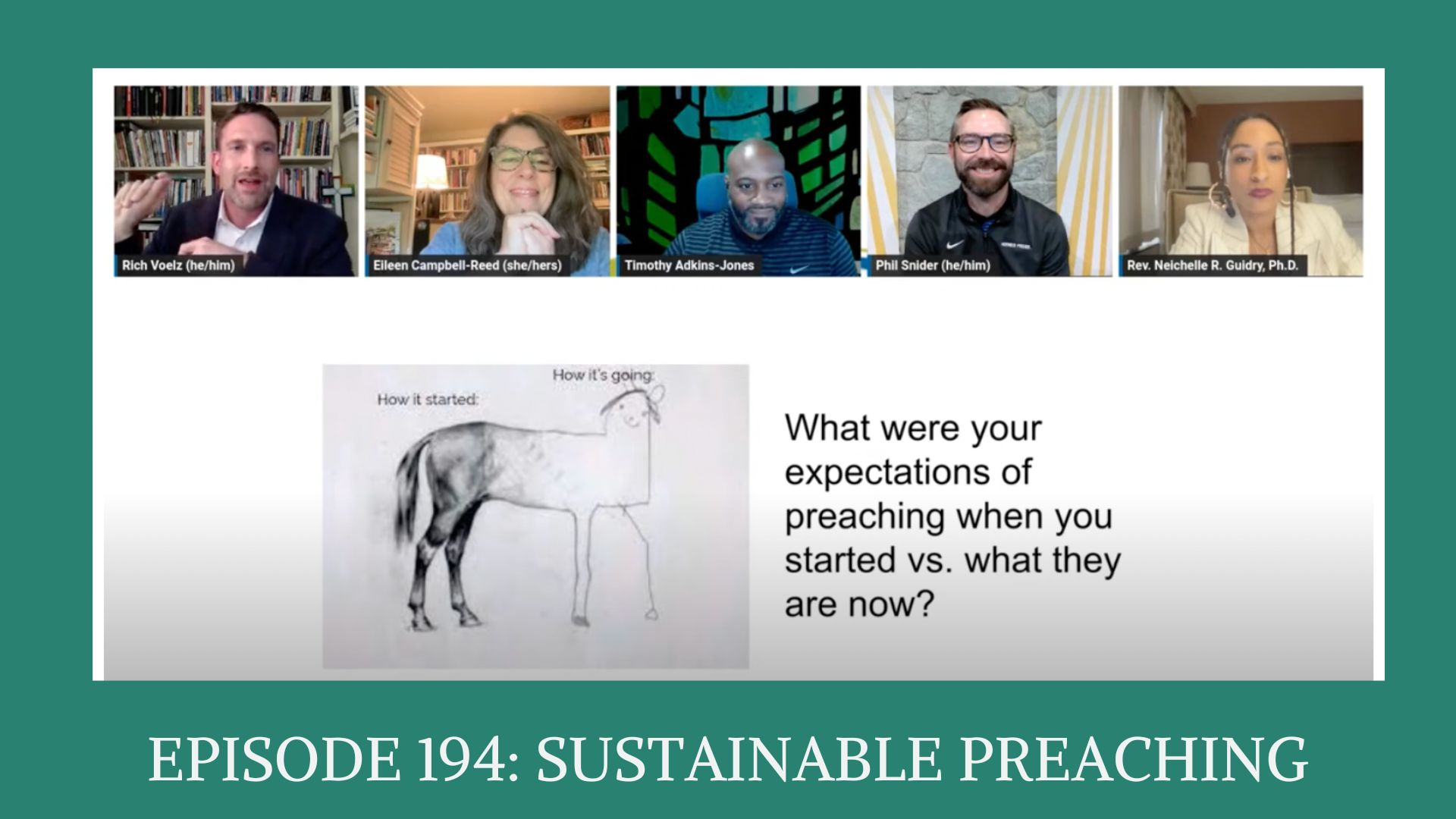A few days ago I took part in a conversation with The Bridge for Early Career Preachers. The focus of the webinar was sustainable preaching. The coordinators for The Bridge, Dr. Rich Voltz and Rev. Mandy England Cole invited me, and they sent thought-provoking questions in advance. This event was the first in a new series of webinars about preaching for the long haul.
I appreciated the invitation. And I really appreciated time with three amazing and prolific preachers. They each shared wisdom, humor, and honesty. I encourage you to watch or listen to the webinar and get to know my Union Theological Seminary colleague, Rev. Dr. Tim Adkins-Jones, Assistant Professor of Homiletics and pastor of the historic Bethany Baptist Church in Newark, New Jersey. You can also hear from two more thoughtful and dynamic preachers. Rev. Dr. Neichelle Guidry is Dean of Sisters Chapel and Director of the WISDOM Center at Spelman College in Atlanta, Georgia. And Rev. Dr. Phil Snider serves as pastor at Brentwood Christian Church in Springfield, Missouri for 20 years.
I enjoyed the opportunity to reflect about preaching. and to hear the reflections of other preachers. It gave me time to think about my own stories of learning and change. And I also considered stories entrusted to me by ministers in the Learning Pastoral Imagination Project, as well as what I reported about preaching in the #PandemicPastoring Report.
I think each of us on The Bridge panel just scratched the surface in this rich conversation. Certainly, there was not time to say everything. Through years of congregational and special occasion preaching, I understand myself to have changed a great deal. And so have the LPI study participants whom I have been observing for the last 14 years.
Preaching as Embodied
As a child and teenager, I never heard a women preach. Attending chapel at my college brought me into contact with my first sermons preached by women. Yet preaching classes in college and seminary asked me to take the work of preaching seriously. And it quickly became a major part of my early understanding of ministry.
The first paragraph of chapter one of my book Pastoral Imagination recalls my first preaching experience.
Stepping into that first hospital room as a CPE student. Getting that first call in the middle of the night to show up for a family whose father just died. Standing up to preach my first public sermon to fewer than a dozen people with a video camera at the back of the chapel broadcasting the service to patient rooms all over the hospital. Having to lead the hymns myself. Ugh.
The whole embodied, relational, emotional experience comes back to me full force with this handful of words. Preaching is not only embodied, it is also embedded in time and space, stories and relationships, preparation and performance.
When we talk about preaching as embodied, it certainly includes the gestures and postures of presenting a sermon. The embodied character of preaching also includes standing (or sitting), speaking from platform, pulpit, or podium. (How is that for alliteration? LOL.)
Yet the embody character preaching is so much more than that. During the time of study and preparation for me, there is the discipline of sitting or walking while reading and listening. The discipline of writing itself is an embodied practice. Also the rhythms of life that are bound up in rest and food and sex and exercise are interwoven in the how and when one prepares a sermon and preaches it. And when preaching is at its best, it is a joy and a delight.
Change Over Time
Let’s take for example food. In the “green room” before The Bridge event, some of us chatted about our inability to eat just before preaching. And we also noted how that has changed over time. I know when I first started preaching in the 90s, it took me three weeks to write a sermon. (Good thing I was not an every week preacher back then!) I most definitely could not eat on any morning that I was scheduled to preach.
As a result I was often ravenous and headachy after the sermon and worship service. I did learn to drink more water even if I could not eat beforehand. And over years of time, my anxious energy levels dropped. Now, I can usually eat a little something — hours before preaching a sermon.
And I learned from good teachers of preaching, how to channel the nervous energy into taking action by creating the sermon. This idea helps me move that energy through my body in a positive way. However, not all of that energy can go into the sermon itself. Some of it lingers in my body and shows up in my rumbling gut or a dull headache.
The embodied character of preaching and leading worship changed dramatically with Covid-19. For new and seasoned preachers alike, the entire situation brought on new challenges.
Pandemic Preaching
In the #PandemicPastoring Report, I tried to capture the experiences shared with me from over a hundred clergy and lay leaders. There was resilience, grace and even moments of delight in the last three years, but also some deep weariness.
Each pastor’s list of losses and desolations weighs heavy. One pastor shared this list: “lack of in-person contact with parishioners, preaching to a video camera in an empty sanctuary, worship without lay participation, and the time pressure that was involved in ‘producing’ recorded worship.”
We preach not only with our words or with ideas, but also our fully embodied selves and our entire lived experience. This one quote from one pastor, gives us a tiny window into why pastors and preachers are exhausted at the moment. They need Sabbath and deep rest and time to process what has happened to them – body and soul.
So much more can and should be said about the embodied character preaching. Once again, I barely scratched the surface. So I’ll leave you with a few questions for your own reflection.
In what ways is preaching an embodied practice for you?
How do the tasks of preparation and sermon delivery impact your body?
Where and how do sermons land with the bodies of listeners?
How has your embodied work of preaching changed with time?
To create habits of sustainable preaching, we have to pay attention to the text and the presence of the holy. We also have to pay attention to our bodies and how they are doing. Preaching is a holistic practice grounded in the sacred and a pastoral imagination. Blessings for your vocation of preaching in all its complexity and may it be a joy.






